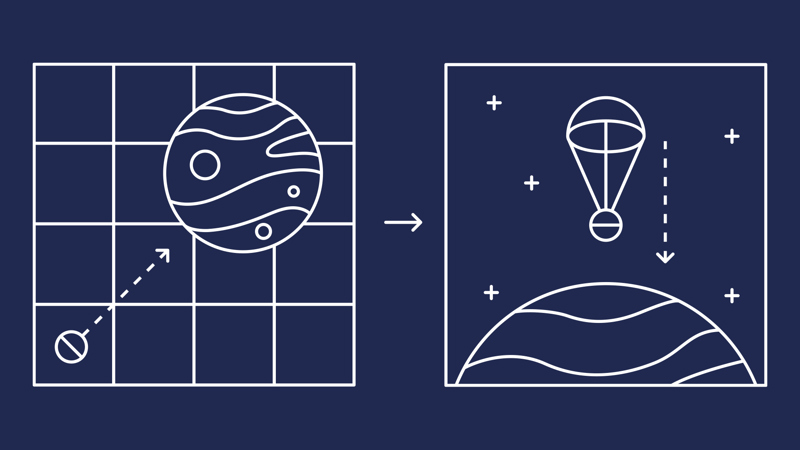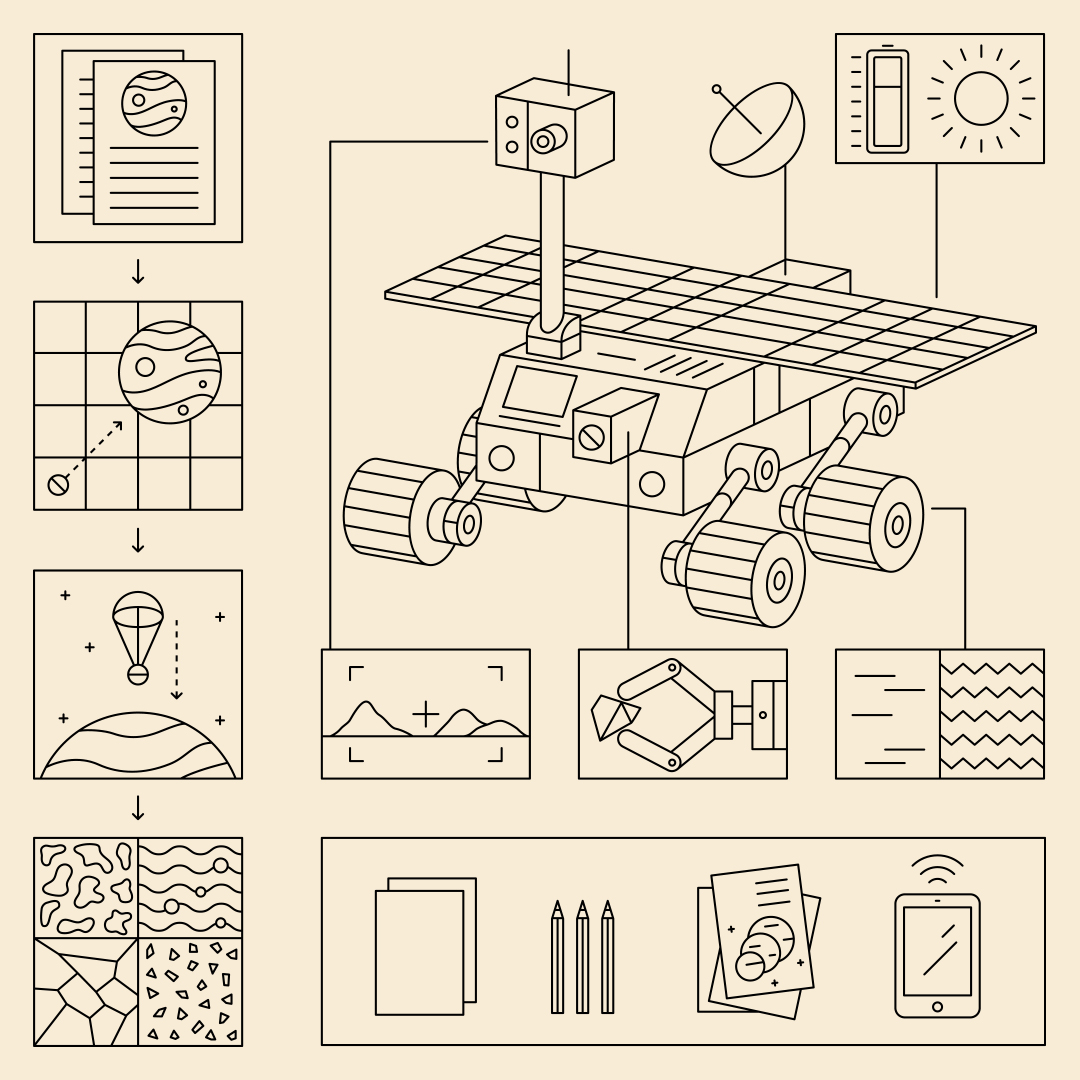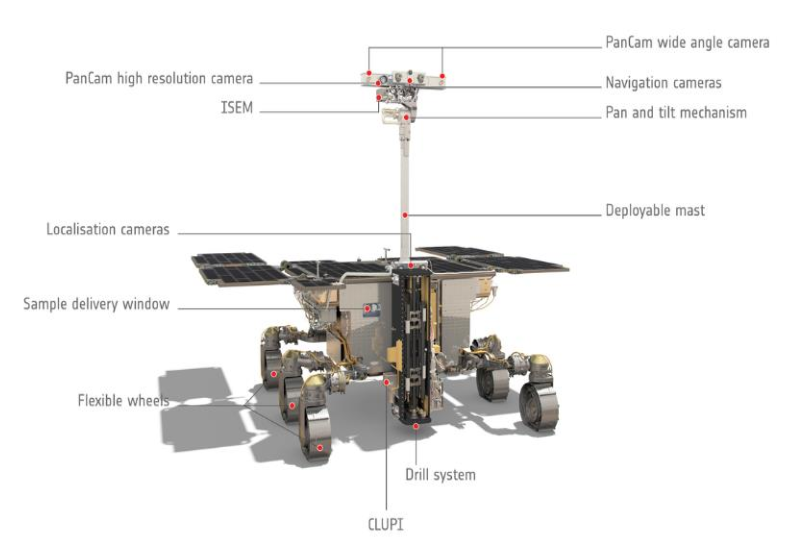
Operation research rover
You’ll need
- A4 paper
- Pens or pencils
- Access to a computer

Before you begin
- This is a great activity to run during an online session. Check out the advice on using Zoom and other popular digital platforms and the guidance on being safe online.
- Decide whether you’ll use breakout rooms so people can work in groups. Zoom have help and guidance about breakout rooms on their website.
There are a lot of different types of space missions. Many of these involve launching robots into space. Robots are equipped with scientific instruments and help us gather data more safely and cheaply than we’d be able to using human explorers. Robots can also help us find out new things about planets that are currently too far away for humans to reach.
Robotic space missions are normally in one or more of four categories:
-
Space probes are spacecraft that travel through space to collect science information. Probes send data back to Earth for scientists to study. One of the most famous probes is Voyager 1. It has travelled further in space than any human-made object. It launched into space in 1977. Voyager 1 flew past Jupiter and Saturn and then headed for the edge of our solar system. As of 1 February 2010, the spacecraft was 16.8 billion kilometres from Earth! An example of a current space probe that the UK is involved with is the James Webb Space Telescope. This has four scientific instruments onboard, contained within the Integrated Science Instrument Module (ISIM). These include the:
-
- Near-infrared camera – as the telescope’s primary imager, this specialist camera is able to detect light from the earliest stars and new galaxies that are in the process of formation.
- Near-infrared spectrograph – used to split light from an object into a spectrum. Analysing the spectrum can tell us about the physical properties of the object, like temperature, mass and chemical composition.
- Mid-infrared instrument (MIRI) – this is both a camera and a spectrograph that allows distant galaxies, newly-forming stars and faintly-visible comets to be seen.
- Fine guidance sensor/near infrared imager and slitless spectrograph – the fine guidance sensor points the telescope in the right direction, while the near infrared imager and spectrograph are used to investigate first light detection and other features.
-
An orbiter is a spacecraft that is designed to orbit a particular distant object in the solar system and perform scientific measurements to send back to Earth. The instruments on board will usually be specifically designed for the object being studied. Examples of current orbiters that the UK is involved with are the Solar Orbiter, BepiColombo and the ExoMars Trace Gas Orbiter.
-
A lander is a robot that is designed to land on a distant object in the solar system and perform scientific measurements to send back to Earth. The instruments on board will be specially designed for the object or planet and have specific tasks to complete. A lander does not have wheels to move and explore the surface of the object or planet, instead it will stay in the place it landed. An example of a current lander that the UK is involved with is the InSight Mars Lander.
-
A rover is exactly like a lander, but it is designed to move and explore the surface of the planet or object it has landed on. An example of current rover that the UK is involved with is the Rosalind Franklin Exomars Rover. Rover instruments are often called payloads. The types of instruments on board vary depending on the aims of the mission, and the kind of information sought. For example, the instruments on-board were designed to gather information about the environmental conditions on Mars. This includes the atmosphere and the geology. There are various cameras, radiation detectors, environmental detectors and atmospheric sensors onboard to do this.
Space mission: Research rover
- The person leading the activity should welcome everyone to the meeting and mute them.
- Everyone should chat about rovers and how they might be useful on space missions. The person leading the activity may need to explain what they are first – we’ve included some information above. Everyone should think about what they’re used for and how they might be useful to people who want to learn more about other planets.
- Everyone should split into small groups. Each group should choose a current space mission and find out: it’s name, where it’s to, what it’s researching, whether it’ll use a rover, and what other equipment it’s using.
- Each group should imagine that they’re the space research team working on this mission. They could give their team a name, if they can think of a clever-sounding one.
- Each space research team should review the information they’ve found out about the mission and prepare themselves for a short interview or press conference to share what the mission will be all about.
- When everyone’s ready (and back in the main meeting), the person leading the activity should choose a group to act as interviewers or journalists and a group to answer the questions.
- The journalists should ask questions about the details of the mission and the space research team should use what they found in their research to share what they know about the mission in as much detail as they can. Other groups should listen and prepare their own questions and answers.
- Everyone should swap the roles around so every group has a turn at being journalists and being interviewed.
- Everyone should get back together with their space research teams and design their own space mission. They should decide which planet they want to research, the features or phenomena they’re researching, and what sort of data they’d need to collect.
- When groups have agreed on a mission, one person in each group should type out the design of their mission.
- When everyone’s finished their mission design, each space research team should swap their design with another group. Each team should now have a new mission dossier in front of them.
- Each team should pretend that they’ve been assigned a new mission by the UK Space Agency. They need to design a rover to help undertake the mission they’ve just received. Each rover will need to be suited to the environments, terrain, travel and data collection or monitoring involved in the mission.
- Each team should spend at least 15 minutes designing their rovers. They should think about how they’ll arrive and land on the planet, the planet’s terrain and temperature, the risk of radiation damage, and what materials could stop it from breaking.
- When everyone’s ready, the groups some together again to share sketches and ideas for how the rover will perform the tasks set out in the mission brief.
- What’s the name of your mission?
- Where’s the mission to?
- How long will it take?
- What do you hope to find out during the mission?
- What equipment will you use?
- Will a rover be used on the mission?

Artist impression of the Mars Rover, showing the instruments that help it to perform its functions. (Source: Airbus UK)
Reflection
This activity turned everyone into a member of a space research team with a space mission to complete. They designed robots, known as rovers, to meet the needs of the mission. What needs did people’s missions have? What problems did their design need to solve? How did people come up with solutions? Maybe people had to think outside the box, try lots of different things, or build on each other’s ideas. Playing your part is really important in space. When he was talking about his experiences in space, Tim Peake said ‘we are a team and we work hard together. We are all equal to each other’. In this activity, people needed to work together to create a design that fulfilled the mission aims. Was it always easy? When else might people need to work as a team in everyday life?
Safety
All activities must be safely managed. You must complete a thorough risk assessment and take appropriate steps to reduce risk. Use the safety checklist to help you plan and risk assess your activity. Always get approval for the activity, and have suitable supervision and an InTouch process.
- Online safety
Supervise young people when they’re online and give them advice about staying safe. Take a look at our online safety or bullying guidance. The NSPCC offers more advice and guidance, too. If you want to know more about specific social networks and games, Childnet has information and safety tips for apps. You can also report anything that’s worried you online to the Child Exploitation and Online Protection Command. As always, if you’ve got concerns about a young person’s welfare, including their online experiences, follow the Yellow Card to make a report.
- When people are interviewing each other you could have everyone asking questions to keep everyone more involved.
- The level of detail the group goes into when researching the current space missions will determine what they can talk about in their interview. The same goes for the designs for the space missions – an epic voyage of discovery is likely to require a super rover!
Give anyone who doesn’t want to write the opportunity to draw pictures instead. In this activity, diagrams are just as helpful.
All Scout activities should be inclusive and accessible.
Continue the challenge by building models of the rovers and instruments everyone designed. The space research teams could use any materials they have at home including clean recycled items, modelling clay, wood, or cardboard.
Groups designed their own space missions, which meant they needed specialised rovers that other groups designed. This allowed everyone to plan a mission where the focus was something the group are interested in.
